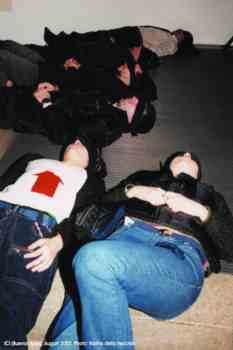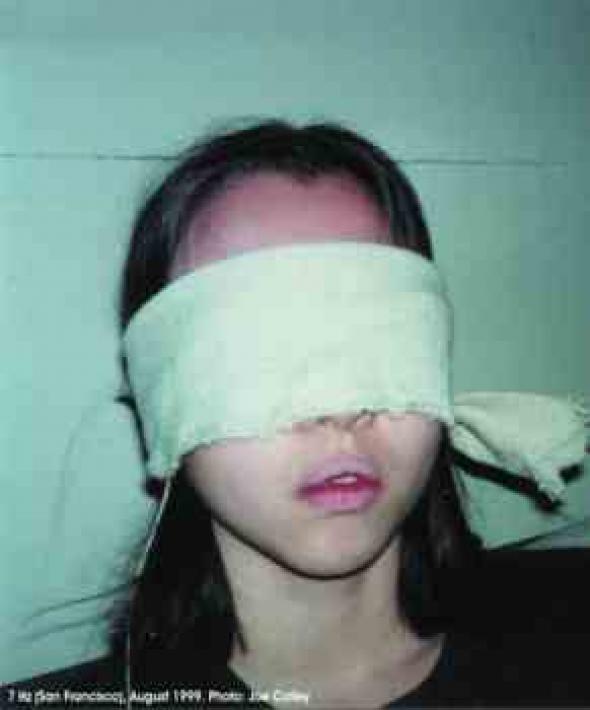Found & Constructed
In the first part of this issue’s review Special, Brandon LaBelle surveys some key practitioners creating sonic performances that mix ‘found’ and mediatised sound – a mix that parallels the wider ‘immaterialisation’ of time and place
Given the current interest in experimental music, sound art, and electronic sound practices, from radio streaming and DJ digressions to real-time sampling processes, it seems increasingly apparent that a convergence is taking place between contemporary experience and the aural in general. There are various theories one could apply to such phenomena in an attempt to historicise this trajectory. Yet it seems part of this historical and theoretical attempt would have to include in its scope a consideration of what is called ‘media’ and its relation to music and the aural. The ambient method and ethos articulated 25 years ago by Brian Eno as defining the electronic, fluid free-fall of space and time, has been actualised in contemporary renderings of the increased ‘immaterialisation’ of experience. This immaterialisation, inherent in the telecommunications networks that permeate all cultural forms, softens and complexifies the borders between user and used, recipient and transmitter, found and sampled. What is striking about this ambient immaterialisation of time and place is that it can be seen as a parallel and sympathetic condition to sound’s very own: a fluid, immaterial flow of information, unfixed and ephemeral, without concrete meaning per se, and drifting between and around bodies. If sound and the state of the immaterial, or the ‘TransUrban’ as the current situation has been called, are somehow aligned, it becomes clearer why sound art as a cultural form is enjoying a new visability with exhibitions proliferating such as Visual Sound at the Mattress Factory, Pittsburgh, Sonic Boom at the Hayward Gallery, London and 010101 at MOMA, San Francisco.
What can be seen in this coupling of sound and media culture is a practice increasingly attuned to the found environment. Maybe this is because media has invaded our understanding and experience of space and place. Certainly, geographical location has undergone a radical shift from industrial fragmentation to what Stephen Graham calls the ‘splintering urbanism’ of today (splintering under the invisible networks that form a ‘secondary’ city or a hovering metropolis to our built ones; a ‘Global City’, invaded by an outside which is increasingly inside). Against this geographical shift we can see how place itself is at stake, as networks produce hybrid and volatile localities. This has resulted in an increased sensitivity to the ambient subtleties of the found environment, both in its analogue and digital forms. This is because what we call media in general asks for input of some kind, whether it be the user, the sampler, the hacker or the network itself, and this input necessarily comes from an outside, from another location, another body. Media situates itself so as to receive and thus fulfill its own function of relay, of signal, of communications. This finds its parallel in an aspect of current sound practice which can be identified with an increased, and a somewhat continued interest, in the outside input of place.
The recent CD release from the London Musician’s Collective, Your Favourite London Sounds compiled by Peter Cusack, is indicative of this glance towards the found-environment. It collects together audio tracks produced in response to the question ‘what is your favourite London sound and why?’ The replies bring into focus a surprisingly rich array of attitudes to the sonic environment. As Cusack suggests, ‘Taken as a whole the favourite sounds reveal a fascinating perspective on London – that of the ear.’ This perspective is markedly unique, for it immerses us in an acutely sensitive ecology whereby the strands of highly individualised understandings of private space mingle with the larger contextual environment in delicate, unexpected and complicated conversations.
Field recording in general (or the recording of environmental sounds) has a long history, and finds its most acute musical articulation in Musique Concrète [see Howard Slater’s ‘Concentrated Listening’, p.56] and Acoustic Ecology, both of which draw upon field recording and environmental sound as musical material, though with differing agendas and ends. Field recording is featured prominently in the Madrid-based, yet ever-nomadic, Francisco Lopez’s work, such as his recent Buildings (New York), a collection of recordings made from various buildings in New York City. The final piece is a long soundscape of slight drones and shifts in textural nuance, a rich palette of the mechanical universe within the architectonics of the city. What distinguishes his work is its ability to probe the inner workings of the found, to not simply rely upon the microphone as an objective instrument, but to situate it inside the very object of study, to, in a sense, subjectify the instrument through marking it with the sonic excess of environments. And at the same time, to withdraw from the specifics of the given situation, and to construct the work into a musical composite. In this way, the world of buildings becomes the world of aural imagining, for ultimately what we as listeners confront is the given moment of actual listening that for Lopez is not necessarily determined by the original object, but how that object in turn is deconstructed and reconstructed, inside the mediatised and electronic reproduction – as a process of ‘trying to reach an ideal of absolute concrète music.’
 The found environment is in a sense a performative situation, for it is always already ahead of our perceptual attention, an ongoing concert of activity. London-based Kaffe Matthews taps into this found concert through her performances. Working with real-time processing using LiSa sampling, violin, and laptop, Kaffe’s performances are a dynamic interplay of the found and the constructed, the phenomenal real and the mediated, from the spatial into the temporal and back again. Positioning microphones to pick up, reconstruct and redistribute the found environment - often sounds of the club or performance spaces themselves, from outside street noise to bar activity - the musical moment becomes an improvised usage of the found as raw material. Here, the acoustic is fed through the electronic to arrive back into the found environment, re-presenting to us that which we are bound up in making, for certainly the body of the audience itself is here wrapped into a self-reflexive unit of interplay and conversation - a kind of aural mirroring through which other views occur, reflected back in a dialogue of presence.
The found environment is in a sense a performative situation, for it is always already ahead of our perceptual attention, an ongoing concert of activity. London-based Kaffe Matthews taps into this found concert through her performances. Working with real-time processing using LiSa sampling, violin, and laptop, Kaffe’s performances are a dynamic interplay of the found and the constructed, the phenomenal real and the mediated, from the spatial into the temporal and back again. Positioning microphones to pick up, reconstruct and redistribute the found environment - often sounds of the club or performance spaces themselves, from outside street noise to bar activity - the musical moment becomes an improvised usage of the found as raw material. Here, the acoustic is fed through the electronic to arrive back into the found environment, re-presenting to us that which we are bound up in making, for certainly the body of the audience itself is here wrapped into a self-reflexive unit of interplay and conversation - a kind of aural mirroring through which other views occur, reflected back in a dialogue of presence.
These technological displacements of what might be called ‘real sound’ have become emblematic of the work of Bill Fontana. Working for the past twenty years, Fontana’s site-specific installations are marked by both a radical usage of technological means and sensitivity to the aural environment. His work Sound Sculpture With a Sequence of Level Crossings from 1982 is a live amplification of sounds along the main railroad line of the Southern Pacific and Amtrak in Berkeley and Emeryville, California. This line is marked by a series of eight railroad crossings which for Fontana indicate a unique aural moment: the trains blow their whistles at these junctions. Placing microphones at these spots and amplifying live sound through telephone lines to a site in Oakland, the sound sculpture displaces and brings into focus, from an entirely altered perspective, the surrounding environment. Throwing sounds across such distances, topples our sense of place and time while at the same moment recuperating it.
These interplays of observer and observed, place and displacement, find further articulation in the work of Achim Wollscheid, a Frankfurt-based media artist working with sound, light and architectural installation. His work presented in Amplitude of Chance at the Kawasaki City Museum in Japan in the summer of 2001 exemplifies the meeting point of technology and the found. Constructing light and sound sampling systems that respond to the environment, from visitors’ voices to movements in a room, Wollscheid’s work sets the stage for an ambient intervention which heightens our relationship to space, time and the very presence we ourselves enact on the given environment. Amplitude of Chance consists of a sampling system attached to the lights of the gallery space. This system in effect alters the lighting of the gallery according to sounds occurring in the space. Dimming, going out, flickering, and remaining, this play of light in relation to found sound brings into conversation, as in Kaffe’s performances, the dynamic between the acoustic and the electronic, the found and the sampled response. This highlights an increased sensitivity to how art may function as an interventionist construction by, as Wollscheid states, ‘withdrawing the object and re-introducing the participant’.
Found sound has its own history, harking back to early deconstructions of musicality by Fluxus, and forwards to its more current manifestation with the pre-set vinyl crackle on numerous samplers, a kind of appropriation of the by-product of record technology as a different sort of ‘found’. This expansion of musical boundaries to include ‘found’ settings seems to precipitate a redefinition of what the sound-object means. For what these works, and sound art in general, indicate is an unraveling of the moment of musical production and an escape from the semantic grip, as the acoustic and the digital, the found and the constructed, are negotiated through the immediacy of the environment.
Brandon LaBelle <otic@earthlink.net> is an artist, editor and publisher of the small Los Angeles art press Errant Bodies
Other projects:Achim Wollscheid: [http://www.selektion.com]Kaffe Matthews: [http://www.annetteworks.com/index.htm]London Musician’s Collective: [http://www.l-m-c.org.uk]
>> Images Francisco Lopez [http://www.franciscolopez.net]
Mute Books Orders
For Mute Books distribution contact Anagram Books
contact@anagrambooks.com
For online purchases visit anagrambooks.com








